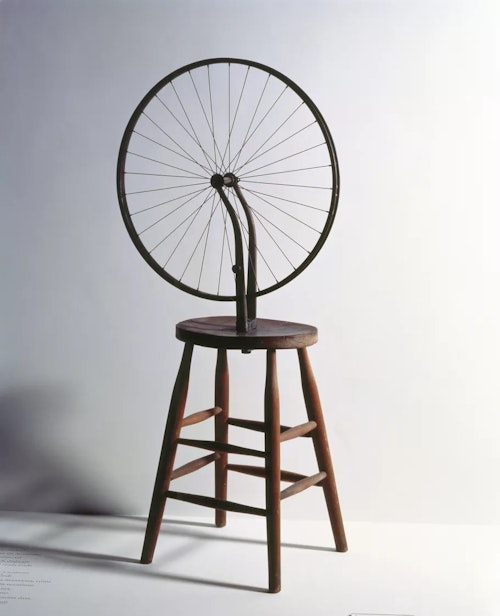
CURATOR’s EYE
Outside and inside of art. Artists of Outsider Art
Follow TRiCERA on Instagram and check out our creative artists
5%OFF & free shipping 1st purchase
FIRSTART5
10%OFF 2nd purchase after 1st purchase!
Welcome to TRiCERA
Hi there! We are pleased to have you here 🎉
Could you please describe yourself?
Guest
Marcel Duchamp is one of the most famous artists of the 20th century, famous as the father of the concept of "contemporary art.
In this issue, we will introduce five of Duchamp's most representative works.
Why is he called the most influential artist of the 20th century? By reading his works, you will find out.
For more information on Duchamp's life, please refer to the article below. Please read it as well.
The Father of Contemporary Art [Marcel Duchamp] Explained
In 1917, "Fountain," exhibited at the Society of Independent Artists in New York, sent shockwaves through the art world.
The work, an overturned male urinal signed "R. Mutt," was vigorously protested by the exhibition committee, who argued that it was not a work of art, even though Duchamp himself was a member of the committee.
Eventually, the association rejected the work, and it was withdrawn from the exhibition, forcing Duchamp to withdraw from the Association of Independent Artists.
This work became a major scandal in the history of art, and caused a great stir among Dadaist artists who valued irrationality, nonsense, and illogic.
At the same time, however, it was a work that presented a revolutionary way of thinking in terms of the principles of contemporary art, namely, to "think and enjoy," and to be a work that constantly and consciously expands the domain of the word "art.
In 2004, it was recognized as "the most influential artwork of the 20th century" by 500 of the world's leading artists and critics of the art world.
Fountain, 1917

The emergence of this painting was truly an "incident" in pictorial representation.
It was influenced by the documentary photography published by a physiologist named Etienne-Jules Murray, who marked the human body and then took a series of instantaneous photographs of the figure in motion. Murray was a physician and physiologist who published these photographs to study human physiology, but at the time this photographic technique had more impact on the art world than on the medical world. At about the same time, a photographer named Edouard Muybridge was publishing a series of photographs of women descending stairs, a visual image that Duchamp directly used as a motif.
Etienne-Jules Murray, "Man Walking," 1890 - 1891.jpg?w=600&h=318)
Edward Muybridge,Woman Walking Downstairs, 1887.
Duchamp was one of the artists who used the results to explore new expressions of "movement.
The body of the moving woman is represented by cylinders and cones, and the series of images are clearly drawn without blurring or blurring.
His style, which combined Cubism and the Futurist art movement, brought a new wind to Modernism.
Readymade is a word that means "ready-made" in Japanese.
Using an object (also called a "found object") made with the intention of using it for some purpose, readymade art is created by attaching or combining multiple readymade objects.
In 1913, Duchamp created a work of readymade art called "Bicycle Wheel.
Bicycle Wheels, 1913
It is a simple piece of art: an upturned bicycle wheel screwed to a wooden stool.
Current research indicates that the idea for this combination was conceived by Elsa von Freitag-Loringhoven, another Dadaist artist who was a close friend of Duchamp. As a work of art, Duchamp is credited with presenting it.
Duchamp had this to say about the readymades: "My idea is to create beauty.
My idea is to select something that does not attract attention either by its beauty or by its ugliness. In other words, I am looking for the indifference that I myself feel when I look at it.
Duchamp's idea of the basic concept of "contemporary art," "a work of art that is experienced by the viewer," is embodied in this quote from Duchamp: "The creative act is the act of making something new, of making something new.
The creative act is not performed by the artist alone. The work is connected to the outside world through the viewer's description and interpretation of the experience of the work. In this way, the artist and the viewer work together to create the work, and the viewer is part of the creative act."
"The creative act is not performed by the artist alone; the spectator brings the work in contact with the external world by deciphering and interpreting its inner qualifications and thus adds his contribution to the creative act."
The work, with its distinctive title that seems to be saying a sentence, was created over a long period of eight years, from 1915 to 1923, with a few disconnects in between.
The "Great Glass" has become the customary appellation for the original title, "The Bride Naked by Her Bachelors, Even."
The Bride Naked by Her Bachelors, Even, 1923
Several symbolic patterns are painted on the surfaces of two large glass plates, using lead foil, fuse wire, and even dust as materials.
The composition is a complex interplay of various elements, including a production process that incorporates chance and the craftsmanship of drawing with materials different from those used in ordinary oil paintings. The artist has also presented a compact multiple work called "Green Box," which is a collection of sketches, photographs, and notes that were created before the meaning and story behind each motif and the final form of the work.
Green Box
The Big Glass was inspired by the setting of Raymond Roussel's famously esoteric novel Impressions of Africa, which was published in 1915 by the Paris-born Duchamp.
The Parisian-born Duchamp worked intensively on "The Big Glass" after he emigrated to the United States in 1915.
The work was abandoned as "unfinished" in 1923. Moreover, when it was transported from the venue where it was first exhibited, the impact caused a large crack in the glass. Duchamp restored it, but intentionally left some degree of cracking in order to preserve the accidental nature of the work.
The Large Glass is divided into two parts, the upper and lower.
The lower part represents the bachelor (male) and the upper part represents the bride (female).
Duchamp's idea is that the narcissistic aspect of the bachelor resembles the repetitive and paranoid nature of the machine. The various machine processes depicted in the lower part of the painting depict a story about sexual love in which the bachelor's sexual desire is vaporized, prompting the bride's undress in the upper part.
Rose Sélavy, spelled "Rrose Sélavy" (or Rose Sélavy), is the name of the character Duchamp himself played as a woman.
The name was punningly given because when pronounced in French, it also sounds like the sentence "Eros, c'est la vie" (sexual love, that's life).
In collaboration with the Dadaist photographer Man Ray, Seravy's portrait work continued into the 1920s. Duchamp also signed several other works under the name "Rose Seravy.
This character ironically refers to the act of romanticizing and falling in love with an artist's individuality and subjectivity. Rose Seravi," who appears at first glance to be an attractive woman, is actually just a man. "You think you are making something that is uniquely yours, but when you look at it a year later, you see the roots of your art without knowing at all where it came from," Duchamp later said in an interview.
It was believed that Duchamp had abandoned production after 1923 and had been working toward a chess competition for almost 25 years. So when this work was unveiled, everyone in the art world was surprised.
The work is a painting made of various materials and can only be seen through a pair of peepholes in a wooden door, corresponding to the two eyes of a human being.
There, against the backdrop of the view, is a nude woman lying on her back, face covered, legs spread, holding a gas lamp in one hand.
The meaning of the work is still subject to interpretation, but the woman was modeled by his girlfriend at the time, Brazilian sculptor Maria Martins.
To learn more about "contemporary art," please read the following article.
What is Contemporary Art After All? The more you know, the more interesting it is!
There are many kinds of contemporary art! Explanation of Contemporary Art by Genre
10 key people to know about contemporary art
View TRiCERA ART's latest works
TRiCERA ART members receive a variety of special privileges and preferences.
- Discounts, including members-only secret sales and coupons
- Create your own collection by registering your favorite artists
- Receive updates on popular artists, exhibitions, and events
- Receive a weekly newsletter with selected art
- Personal Assessment to find out what kind of art you like.
Please register as a member for free and receive the latest information.

Writer
TRiCERA ART
Marcel Duchamp is one of the most famous artists of the 20th century, famous as the father of the concept of "contemporary art.
In this issue, we will introduce five of Duchamp's most representative works.
Why is he called the most influential artist of the 20th century? By reading his works, you will find out.
For more information on Duchamp's life, please refer to the article below. Please read it as well.
The Father of Contemporary Art [Marcel Duchamp] Explained
In 1917, "Fountain," exhibited at the Society of Independent Artists in New York, sent shockwaves through the art world.
The work, an overturned male urinal signed "R. Mutt," was vigorously protested by the exhibition committee, who argued that it was not a work of art, even though Duchamp himself was a member of the committee.
Eventually, the association rejected the work, and it was withdrawn from the exhibition, forcing Duchamp to withdraw from the Association of Independent Artists.
This work became a major scandal in the history of art, and caused a great stir among Dadaist artists who valued irrationality, nonsense, and illogic.
At the same time, however, it was a work that presented a revolutionary way of thinking in terms of the principles of contemporary art, namely, to "think and enjoy," and to be a work that constantly and consciously expands the domain of the word "art.
In 2004, it was recognized as "the most influential artwork of the 20th century" by 500 of the world's leading artists and critics of the art world.
Fountain, 1917

The emergence of this painting was truly an "incident" in pictorial representation.
It was influenced by the documentary photography published by a physiologist named Etienne-Jules Murray, who marked the human body and then took a series of instantaneous photographs of the figure in motion. Murray was a physician and physiologist who published these photographs to study human physiology, but at the time this photographic technique had more impact on the art world than on the medical world. At about the same time, a photographer named Edouard Muybridge was publishing a series of photographs of women descending stairs, a visual image that Duchamp directly used as a motif.
Etienne-Jules Murray, "Man Walking," 1890 - 1891.jpg?w=600&h=318)
Edward Muybridge,Woman Walking Downstairs, 1887.
Duchamp was one of the artists who used the results to explore new expressions of "movement.
The body of the moving woman is represented by cylinders and cones, and the series of images are clearly drawn without blurring or blurring.
His style, which combined Cubism and the Futurist art movement, brought a new wind to Modernism.
Readymade is a word that means "ready-made" in Japanese.
Using an object (also called a "found object") made with the intention of using it for some purpose, readymade art is created by attaching or combining multiple readymade objects.
In 1913, Duchamp created a work of readymade art called "Bicycle Wheel.
Bicycle Wheels, 1913
It is a simple piece of art: an upturned bicycle wheel screwed to a wooden stool.
Current research indicates that the idea for this combination was conceived by Elsa von Freitag-Loringhoven, another Dadaist artist who was a close friend of Duchamp. As a work of art, Duchamp is credited with presenting it.
Duchamp had this to say about the readymades: "My idea is to create beauty.
My idea is to select something that does not attract attention either by its beauty or by its ugliness. In other words, I am looking for the indifference that I myself feel when I look at it.
Duchamp's idea of the basic concept of "contemporary art," "a work of art that is experienced by the viewer," is embodied in this quote from Duchamp: "The creative act is the act of making something new, of making something new.
The creative act is not performed by the artist alone. The work is connected to the outside world through the viewer's description and interpretation of the experience of the work. In this way, the artist and the viewer work together to create the work, and the viewer is part of the creative act."
"The creative act is not performed by the artist alone; the spectator brings the work in contact with the external world by deciphering and interpreting its inner qualifications and thus adds his contribution to the creative act."
The work, with its distinctive title that seems to be saying a sentence, was created over a long period of eight years, from 1915 to 1923, with a few disconnects in between.
The "Great Glass" has become the customary appellation for the original title, "The Bride Naked by Her Bachelors, Even."
The Bride Naked by Her Bachelors, Even, 1923
Several symbolic patterns are painted on the surfaces of two large glass plates, using lead foil, fuse wire, and even dust as materials.
The composition is a complex interplay of various elements, including a production process that incorporates chance and the craftsmanship of drawing with materials different from those used in ordinary oil paintings. The artist has also presented a compact multiple work called "Green Box," which is a collection of sketches, photographs, and notes that were created before the meaning and story behind each motif and the final form of the work.
Green Box
The Big Glass was inspired by the setting of Raymond Roussel's famously esoteric novel Impressions of Africa, which was published in 1915 by the Paris-born Duchamp.
The Parisian-born Duchamp worked intensively on "The Big Glass" after he emigrated to the United States in 1915.
The work was abandoned as "unfinished" in 1923. Moreover, when it was transported from the venue where it was first exhibited, the impact caused a large crack in the glass. Duchamp restored it, but intentionally left some degree of cracking in order to preserve the accidental nature of the work.
The Large Glass is divided into two parts, the upper and lower.
The lower part represents the bachelor (male) and the upper part represents the bride (female).
Duchamp's idea is that the narcissistic aspect of the bachelor resembles the repetitive and paranoid nature of the machine. The various machine processes depicted in the lower part of the painting depict a story about sexual love in which the bachelor's sexual desire is vaporized, prompting the bride's undress in the upper part.
Rose Sélavy, spelled "Rrose Sélavy" (or Rose Sélavy), is the name of the character Duchamp himself played as a woman.
The name was punningly given because when pronounced in French, it also sounds like the sentence "Eros, c'est la vie" (sexual love, that's life).
In collaboration with the Dadaist photographer Man Ray, Seravy's portrait work continued into the 1920s. Duchamp also signed several other works under the name "Rose Seravy.
This character ironically refers to the act of romanticizing and falling in love with an artist's individuality and subjectivity. Rose Seravi," who appears at first glance to be an attractive woman, is actually just a man. "You think you are making something that is uniquely yours, but when you look at it a year later, you see the roots of your art without knowing at all where it came from," Duchamp later said in an interview.
It was believed that Duchamp had abandoned production after 1923 and had been working toward a chess competition for almost 25 years. So when this work was unveiled, everyone in the art world was surprised.
The work is a painting made of various materials and can only be seen through a pair of peepholes in a wooden door, corresponding to the two eyes of a human being.
There, against the backdrop of the view, is a nude woman lying on her back, face covered, legs spread, holding a gas lamp in one hand.
The meaning of the work is still subject to interpretation, but the woman was modeled by his girlfriend at the time, Brazilian sculptor Maria Martins.
To learn more about "contemporary art," please read the following article.
What is Contemporary Art After All? The more you know, the more interesting it is!
There are many kinds of contemporary art! Explanation of Contemporary Art by Genre
10 key people to know about contemporary art
View TRiCERA ART's latest works
TRiCERA ART members receive a variety of special privileges and preferences.
- Discounts, including members-only secret sales and coupons
- Create your own collection by registering your favorite artists
- Receive updates on popular artists, exhibitions, and events
- Receive a weekly newsletter with selected art
- Personal Assessment to find out what kind of art you like.
Please register as a member for free and receive the latest information.

Writer
TRiCERA ART